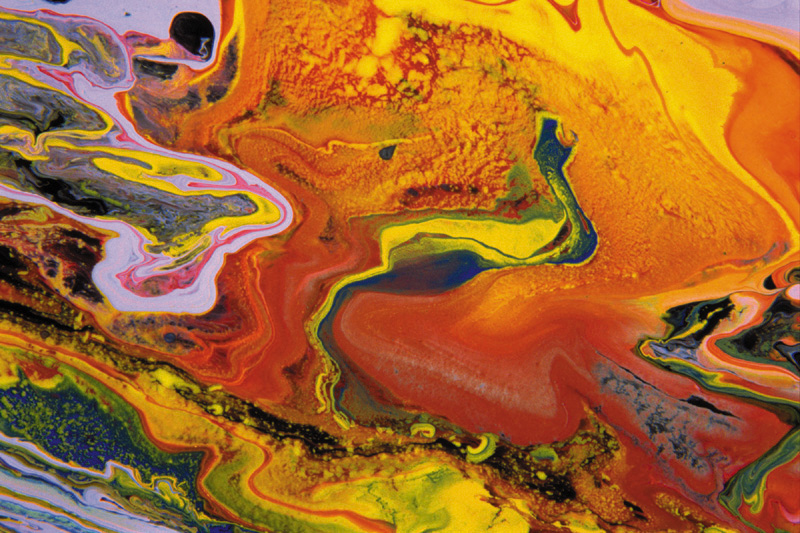EVOGENIO® - Evolutionäre Kunst
Dr. Günter Bachelier - The basic level of my Evolutionary Art
 The basic level refers to
the production of individual works of art. This first level raises
purely artistic questions about shape, composition and colour.
The basic level refers to
the production of individual works of art. This first level raises
purely artistic questions about shape, composition and colour. I was strongly influenced by art styles such as Informel {MuseumOstwall2002a, MuseumOstwall2002b, MuseumOstwall2003, MuseumOstwall2004}, Abstract Expressionism {Herskovic2003} and Action Painting, as well as by artists such as Hans Hartung {Hartung1981} and Jackson Pollock {VarnedoeKarmel1998}.
Pollock's dripping technique led me to the development of different methods of self-organizing painting, long before I came across the term "self-organizing painting". I was, and still am, fascinated by the ability of materials to build complex structures only by means of their physical and chemical properties. These structures are dynamic and the most interesting of them are far from balance. Therefore, capturing these interesting structures by photographing them was natural to me, which led me to abstract photography. A large archive of abstract photographs was accumulated over the years and they were digitized in the early 1990's. This marks a turning point because my work shifted from conventional visual art, such as painting, to computer aided art, using, however, conventional image processing methods.
These abstract (macro) photos have associations to satellite images of the earth and other planets. This is no coincidence because the dynamic effects that shape landscapes and atmospheric structures belong to the same class as the effects that shape the structures in self-organizing painting (dynamic structures in fluids, see fig.1).
Fig.1: Example of a digitized macro photo as part of a self-organized painting (PCD_001_24_P_046)

The idea of a "contrast aesthetics" developed over the years and I tried to recombine contrasting and partially contradicting concepts to create both aesthetic and interesting works. The biological concept of symbiosis constituted an increasingly important metaphor for this integration. To date, the following concepts have been integrated in my works:
- symbiosis of self-organizing painting (Informel, Abstract Expressionism) and geometric/constructive art (concrete art {Rotzler1995})
- symbiosis of biomorphic shapes ({Gielis2003}) and hard-edge painting shapes
- symbiosis of symmetry and symmetry breaking ({GrünbaumShephard1986})
- symbiosis of local and global symmetry
Questions about symmetry and symmetry breaking have become specially under focus in the last two years. Bilateral symmetry is used in most cases because there are neural and evolutionary biological correlations to aesthetic feelings. This is shown by the scientific research on aesthetics which can be exemplified by studies about the attractiveness of faces. Given that social beings humans depend on recognizing and interpreting faces and facial expressions, a large part of the visual system is focused on face recognition. Faces have an overall bilateral symmetry, although they present plenty of small local symmetry breaking (the same can be said about the bodies of most animals). Therefore, the visual system specializes in recognizing bilateral symmetry and its deviations.
There is a long standing hypothesis according to which symmetric faces are more often selected, given the task to select faces with higher attractiveness {ThornhillGangestad1993}. Some empirical studies validate this hypothesis {ThornhillGangestad1993} specially if female subjects are selecting male faces, although other studies came to inconclusive results ({Braun2001}, {Johnstone1994}. The attractiveness of symmetric faces could be explained by evolutionary biology. The deviation from a symmetric ideal could point towards development alterations which might be caused by genetic defects or by parasitic influences. Both cases would possibly affect reproduction success, therefore, reproduction partners with symmetric properties are preferred. Such an explanation would indicate that aesthetics has an established foundation in evolutionary biology {VolandGrammer2003}.
The starting point for me to develop a meta-strategy to find a balance between symmetry and symmetry breaking, was based on the positive correlation between symmetry and aesthetic feeling (on the one hand) and between symmetry and boredom after some time of perception (on the other), so as to find aesthetic and interesting works of art.
References
- C. Braun, M. Gründl, C. Marberger, and C. Scherber. Beautycheck - Ursachen und Folgen von Attraktivität. Technical report, Lehrstuhl für Experimentelle und Angewandte Psychologie Universität Regensburg, 2001.
- Museum Ostwall Dortmund, editor. Informel Bd.1: Der Anfang nach dem Ende. Museum Ostwall, Dortmund, 2002.
- Museum Ostwall Dortmund, editor. Informel Bd.2: Begegnung und Wandel. Museum Ostwall, Dortmund, 2002.
- Museum Ostwall Dortmund, editor. Informel Bd.3: Die Plastik - Gestus und Raum. Museum Ostwall, Dortmund, 2003.
- Museum Ostwall Dortmund, editor. Informel Bd.4: Material und Technik. Museum Ostwall, Dortmund, 2004.
- Johan Gielis, editor. Inventing the Circle - The Geometry of Nature. Geniaal Press, Antwerpen, November 2003.
- Branko Grünbaum and Georey C. Shephard, editors. Tilings and Patterns. Freeman, New York, 1986.
- Hans Hartung and Ulrich Krempel. Hans Hartung - Malerei, Zeichnung, Photographie. HWS Verlagsgesellschaft m.b.H, Berlin, 1981. Ausstellung in der Städtischen Kunsthalle Düsseldorf und der Staatsgalerie moderner Kunst München.
- Marika Herskovic, editor. American abstract expressionism of the 1950s - an illustrated survey with artists’ statements, artwork, and biographies. New York School Press, Franklin Lakes, NJ, 2003.
- Rufus A. Johnstone. Female preference for symmetrical males as a by-product of selection for mate recognition. Nature, 372:172–175, 1994.
- Willy Rotzler. Konstruktive Konzepte. Eine Geschichte der konstruktiven Kunst vom Kubismus bis heute. Zürich, 3nd edition, 1995.
- R. Thornhill and S.W. Gangestad. Human facial beauty. averageness, symmetry and parasite resistance. Human Nature, 33:64–78, 1993.
- Kirk Varnedoe and Pepe Karmel. Jackson Pollock. Tate Publishing, London, 1998.
- E. Voland and K. Grammer. Evolutionary Aesthetics. Springer Verlag, Berlin, 2003.